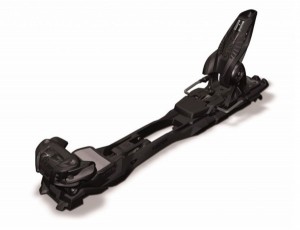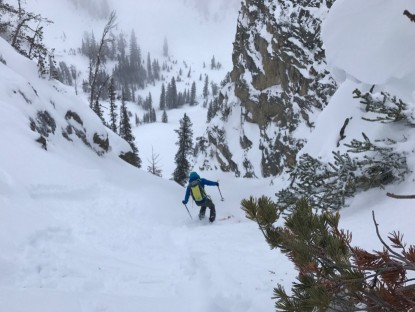The Duke EPF has been updated to accommodate more aggressive skiers. See below for details and comparison photos.
December 2019Marker Duke EPF Review
Our Verdict
Our Analysis and Test Results
The New Duke Pro EPF 18 vs. the Old Duke EPF 16
We tested the Duke EPF 16, but Marker has upped their game this year for those aggressive skiers who just need a higher DIN setting. Their new offering, the Duke Pro EPF 18, has a DIN range of 8 to 18. Check out the new Pro version below (left), followed by the older version we tested (right).
With this update, there is a price increase, up from $450 to $479. As we have yet to test the latest model, the rest of the review speaks only to the performance of the version we tested.
Hands-On Review of the Duke EPF
Ease of Use
These bindings are quite straightforward to step into for downhill skiing and are just as easy as a comparable downhill binding. For lighter users (sub 135 lbs) the heel is very hard to get to engage. If you are close to, or lighter than around 135 lbs, we'd recommend going with the Marker Baron 13 EPF, which is noticeably easier to step into. As a whole, this model is easier to step into than any tech style binding; just insert your toe into the toe piece and slam your heel down. The heel risers that flip downward into position are very useful and aren't hard to engage, but are the most challenging of any binding in our review.
Touring Performance
Overall, this contender is the poorest performing pure touring binding in our review; this is due to its weight, poor pivot point, and most challenging transition. This pair of bindings do not tour as well as most other frame bindings; the Fritschi Freeride Pro features a noticeably more efficient pivot point and more natural stride. The Fritschi Freeride Pro is also easier to get into, but doesn't offer quite as good of downhill performance. Overall and weight aside, the Duke and the Baron's touring performance is identical; both offer the same heel risers, overall transitional design, and the same pivot point.
Transitions
This model, along with the identically transitioning Baron, has one of the more involved transition processes of any binding in our review. No matter what, you'll have to take your boot out of the binding in order to transition either from ski mode from downhill mode or vice versa. The leaver that is switched to achieve this transition is located under the heel of the boot and takes a fair amount of force to flip over; some of our testers noted that is was very difficult at times and even commented that it felt like a struggle. This leaver pushes the binding back along rails which transition from skinning to skiing downhill; these rails are prone to icing up, and a 3 mm plastic scraper goes a long way towards getting the ice out. Compared with other frame style bindings, again, this model doesn't transition nearly as easily as the Fritschi Freeride Pro, and only was slightly more challenging than the similar style binding, the Salomon Guardian MNC 16.
Downhill Performance
This is where this competitor truly excels; there is no better touring binding that performs better on the downhill than this competitor (this includes the Salomon Guardian MNC 16, which we have skied, but didn't include in their review). The same rails are slightly prone to icing and require a fair bit of force to travel on while transitioning; they also provide a ton of surface area and create a super positive binding-to-ski and boot-to-binding connection. Essentially, this competitor feels and performs like a downhill binding, or at least as close as you can come to it while using a touring binding.
These bindings also feature 36 mm stack height; this is fairly low for a frame style binding and is slightly lower than the Fritschi Freeride. The only frame style binding with a lower stack height is the Salomon Guardian MNC 16, which stands 10 mm lower, at 26 mm. The EPF stands for "Extended Power Frame" and refers to Marker's widening of their screw pattern and Chasis of their current binding over the older version; this has increased to 28% as a means of upping the power transmission from the boot, through the binding, and into the ski.
Folks sometimes do not love that the bindings feel noticeably heavier while underfoot and when skiing downhill (when compared to more traditional alpine bindings). Our testers noticed this but didn't think it was a deal breaker, as this model is lighter weight than the Salomon Guardian.
Durability
This model is tough and is the burliest binding in our review. Sure you might have heard of someone breaking some part of almost any touring binding, but for the numbers sold, very few folks manage to break or even damage the Duke EPF (more than cosmetically speaking).
Weight
This model is heavy; at 2760 g or 6 lbs 2 oz for a size small, this is the heaviest binding in our review and double the weight of a majority of the tech bindings we tested. The Baron 13 EPF, which features a lower DIN (6-12), and more plastic in some places where the Duke uses metal, checks in at 2600 g, while the Fritschi Freeride Pro is over a pound and a half lighter and tips the scales at 2200 g, or 4 lb 8 oz. The comparable Salomon Guardian MNC 16 weighs in nearly half a pound heavier at 2960 g, or 6 lb 8 oz per pair.
Best Applications
This pair of bindings is for those that will ski in-bounds 70% or more of the time, and tour 30% or less. The burliness and downhill performance will leave few folks wishing they would have put a more traditional alpine binding on their skis instead. This model can be a good binding for someone who is buying a new set up and thinks they might want to do some touring in the future.
Duke Versus Baron
While this model is definitely burlier and boasts a release value of 16, most users will do just fine with the Baron, as the Baron's durability and 13 DIN rating is more than adequate for most users. If you're really rough with your gear, or you regularly run the release value above 12, consider this pair of bindings.
Value and the Bottom Line
At $479, this contender is one of the better priced touring bindings on the market and is less expensive than many other touring bindings. These are cheaper than all the tech bindings in our review, with the exception of the Dynafit Speed Turn, which retail for $350. They are the least expensive when compared to all of the frame style bindings, though a pair of the less burly Baron bindings will leave you with $100 more in your pocket. For a fairly good price, you'll get a binding that is nearly as durable as they come; they will give you as good as it gets performance and are straightforward to get into.
Conclusion
While the Duke isn't the best all-around touring binding, they do perform well. They offer exceptional performance while skiing downhill and give you the ability to free your heel, put your skins on, and get out there and go touring.






